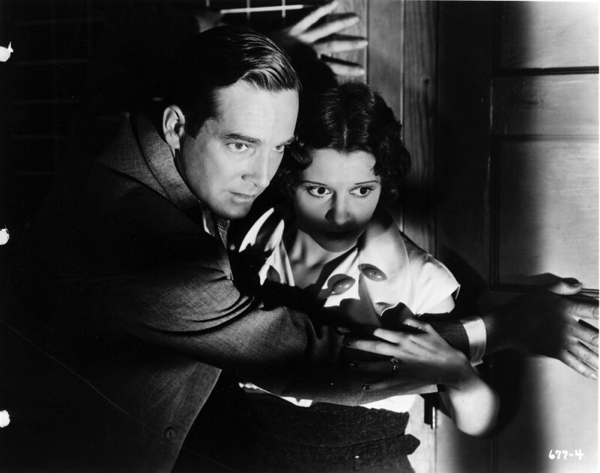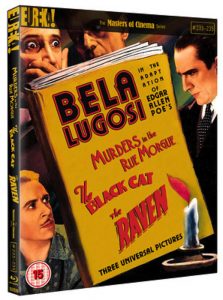
 This trio of classic 1930s horror films—Murders in the Rue Morgue, The Black Cat, and The Raven—is also distinguished by a trio of factors regarding their production. Most notably, each film is based on a work by master of the macabre Edgar Allan Poe. Part of the legendary wave of horror films made by Universal Pictures in the 30s, all three feature dynamic performances from Dracula‘s Bela Lugosi, with two of them also enlivened by the appearance of Frankenstein‘s Boris Karloff. And finally, all three benefit from being rare examples of Pre-Code studio horror, their sometimes startling depictions of sadism and shock a result of being crafted during that brief period in Hollywood before the enforcement of the Motion Picture Production Code’s rigid guidelines for moral content.
This trio of classic 1930s horror films—Murders in the Rue Morgue, The Black Cat, and The Raven—is also distinguished by a trio of factors regarding their production. Most notably, each film is based on a work by master of the macabre Edgar Allan Poe. Part of the legendary wave of horror films made by Universal Pictures in the 30s, all three feature dynamic performances from Dracula‘s Bela Lugosi, with two of them also enlivened by the appearance of Frankenstein‘s Boris Karloff. And finally, all three benefit from being rare examples of Pre-Code studio horror, their sometimes startling depictions of sadism and shock a result of being crafted during that brief period in Hollywood before the enforcement of the Motion Picture Production Code’s rigid guidelines for moral content.
Director Robert Florey, who gave the Marx Brothers their cinema start with The Cocoanuts in 1929, worked with Metropolis cinematographer Karl Freund to give a German Expressionism look to Murders in the Rue Morgue (1932), with Lugosi as a mad scientist running a twisted carnival sideshow in 19th-century Paris, and murdering women to find a mate for his talking ape main attraction. Lugosi and Karloff teamed forces for the first time in The Black Cat, a nightmarish psychodrama that became Universal’s biggest hit of 1934, with Detour director Edgar G. Ulmerbringing a feverish flair to the tale of a satanic, necrophiliac architect (Karloff) locked in battle with an old friend (Lugosi) in search of his family. Prolific B-movie director Lew Landers made 1935’s The Raven so grotesque that all American horror films were banned in the U.K. for two years in its wake. Specifically referencing Poe within its story, Lugosi is a plastic surgeon obsessed with the writer, who tortures fleeing murderer Karloff through monstrous medical means.
THE BLACK CAT
Dir.: Edgar Ulmer; Cast: Boris Karloff, Bela Lugosi, Lucille Lund, David Manners, Julie Bishop, Harry Cording, Egon Brecher; USA 1934, 69 mins.
When Moravian born director Edgar G. Ulmer (1904-1972) directed The Black Cat, losely based on a story by Edgar Allan Poe and adapted for the screen by Peter Ruric, he teamed up legendary horror stars Boris Karloff and Bela Lugosi for the first of seven co-operations. Ulmer, who had worked in Vienna with Max Reinhardt and co-directed Menschen am Sonnatg (1930), first went to Hollywood in 1926 to assist Murnau on Sunrise. After the Nazis took power in 1933, Ulmer then returned to Hollywood, directing Damaged Lives in the same year. He had a great future ahead of him – before falling in love and eloping with Shirley Castle, wife of the producer who also happened to be a nephew of Carl Laemmle, the Universal Studio boss. Ulmer was blacklisted by the major studios for marrying Shirley, so was relegated to working for Producers Releasing Corporation, the lowest of Hollywood’s Poverty Row studios. Despite this he directed a string of successes including the famous noir Detour (1945) with a meagre budget of USD 20,000. Soon he could command better budgets with runaway success Ruthless (1948), bringing out a great performance from Hedy Lamar. Ulmer also made features in Jiddish, amongst them Amerikaner Schadchen (1940) and the most famous Jiddish/American film Green Fields (1937). He ended his working career with a return to Europe, and Germany (Meineid Bauer, 1956) and Italy (Cavern, 1964).
The Black Cat sees American newlyweds Peter (Manners) and Joan Alison (Bishop) on route for their honeymoon in Hungary. Travelling in a train carriage they meet Hungarian psychiatrist Dr. Vitus Werdegast (Lugosi) who despite his sinister appearance and woeful tale of discontent is in fact a goodie in this surreal charade, . While sharing a cab to their destination Joan is injured, forcing the trio to hole up in the imposing modernist villa of Hungarian architect Hjalmar Poelzig (Karloff), built on the ruins of First World War Fort Marmorus.
It soon emerges that Werdegast was denounced by Poelzig, spending 17 years in a prison camp in Siberia, Poelzig marrying his (now dead) wife Karen, and sharing a bed with their entranced daughter also called Karen (both played by a luminous Lucille Lund). In an extraordinary twist, Werdegast suffers from ailurophobia – a fear of cats – and kills one of Poelzig’s black cats much to his Satanist host’s anger.
Poelzig intends to sacrifice Joan, Werdegast pledging to save her, and her husband, by beating Poelzig at chess, but sadly losing the game. Poelzig and his ghastly servant Thamal (Cording) attack Peter and carry Joan to her fate in his catacombs underneath the building. Werdegast chains Poelzig to a rack, threatening to skin him alive, while Joan desperately tries to get the key to the chamber of horrors. Peter awakes, and accidentally shoots Werdegast who blows up the whole building with Poelzig and his cult members.
Ulmer acted as his own costume and set designer in Poelzig’s Bauhaus construct of steel and glass. DoP John Mescall (The Invisible Man, Bride of Frankenstein) moves the camera along vertical lines, creating a maze-like atmosphere. Lugosi cleverly manages to convince us, playing against type in his role as a mournful character full of bitterness and regret. In some way Ulmer must have understood his miserable hero, having been thwarted and blackballed himself, this time from directing major features – and just for falling in love with the wrong person.
MURDERS IN THE RUE MORGUE
Dir.: Robert Florey; Cast: Bela Lugosi, Sidney Fox, Leon Ames; USA 1932, 62 min.
Based on the short story of the same name by Edgar Allan Poe, and adapted for the screen by Tom Reed and Dale van Every, Poe’s fictional detective Pierre Dupin making his first appearance in this delicately rendered arthouse gem. Director Robert Florey (Till we Meet Again) was involved in Frankenstein (1931), but was assigned by Universal to Murders in the Rue Morgue. It stars Bela Lugosi, born 1882 as Bela Ferenc Dezsö Blasko in Hungary, who had made the burgeoning horror genre his own since appearing as Dracula (1931) in Tod Browning’s version of the legend.
Set in a fake but fabulous Paris of the turn of the century, Dr. Mirakle (Lugosi) uses his pet gorilla Erik on sideshows in fair grounds. But this is just a cover for his murderous activities with young women, whom he injects with ape blood in a bid to find a mate for Eric, his unsuccessful attempts given rise to a slew of murders in the titular road. When Mirakle comes across Dupin (Ames) and his finance Camille L’Espanage (Fox), Erik is so taken by the young woman it nearly strangles Dupin in a fit of jealousy, but Mirakle finally succeeds in kidnapping Camille with the intention of making her his ape’s bride. The body of Camille’s mother is found stuffed into a chimney, clutching ape fur. Dupin and the police chase down Mirakle, who is killed by Erik, before running off with Camille, Dupin coming to the rescue.
Shot by the great Karl W. Freund (The Last Laugh), Murders is very much based on the school of German expressionism. Long shadows dominate, and the hero is always with his back to the wall, gaining the sympathy of the audience, Dr. Mirakle channelling his namesake Calligari. There are also undertones of Frankenstein, proof of Florey’s involvement as script writer – he himself was replaced by James Whale, Lugosi losing out to Boris Karloff in the title role.
Dir.: Lew Landers (Louis Friedlander); Cast: Boris Karloff, Bela Lugosi, Irene Ware, Lester Matthews; USA 1935 61 min.
Prolific director Lew Landers (1901-1962), whose credits include Law of the Underworld and Bad Lands, bases The Raven on Edgar Allan Poe’s narrative poem, hiring David Boehm to write the screenplay. And once again it stars ‘the terrible twins’ of the genre, Boris Karloff and Bela Lugosi.
Jean Thatcher (Ware) is gravely injured in a car accident. Her father, an eminent judge, implores the best surgeon in the land Dr. Vitus Vollin (Lugosi) to save her. Vollin does his stuff and befriends the grateful Jane, expressing his obsession for Edgar Allen Poe’s work, his homemade collection of Poe-inspired torture instruments: pit, pendulum, razor, and the shrinking room guarded by his talisman the Raven. Vollin soon becomes obsessed by Jean, despite the protestations of her father who vehemently opposes the union. But Vollin is not to be thwarted, and engages the services of escape convict Edmond Bateman (Karloff) in a Faustian pact, proposing to surgically change Bateman’s looks if he agrees to assist him in an evil act of evil revenge on the Thatcher family. The elegantly crafted thriller touches on themes of devotion, obsession and revenge in a series of gripping plot twists underpinned by Vollin’s lament at love lost that turns to anger.
DoP Charles Stumar (Werewolf of London), born in the Austro-Hungarian Empire, uses light and shadows brilliantly, before ending in a magnificent creshendo, when the love-mad doctor is literally obliterated. Karloff again plays the innocent victim/aggressor, with great humanity.
ON Limited Edition (3000 copies only) Blu-RAY from 20 JULY 2020